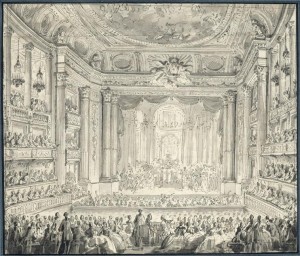When the architect Ange-Jacques Gabriel was given the project of building an opera house for the Palace of Versailles, he accepted with trepidation. The plan for a Royal Opera has been in the minds of the courtiers for almost a century yet circumstances worked to stunt each effort to build it. The price of war more than anything else delayed construction. The wars were never ending. And so, while princes around Europe boasted about their palace theaters, Versailles’ monarchs made do with the makeshift. Temporary theaters were constructed in the gardens, on the marble court in front of the King’s bedroom, in a large salon or stair well for more or less intimate theater, and most impressively, in the large stables. But after a serious fire in which the stable theater was destroyed, Louis XV committed the funds and directed Gabriel to design a great theater. Gabriel, at the age of 70 was considered the master architect of France. He felt that he must create something of historical importance.
Among other points of genius, I have always admired François Couperin because he was able to excel in the grand Baroque style he inherited and also create a new light, witty, sensual rococo style. Thus he was able to complete the past and also steer everyone into a future of his own designed. Likewise, Gabriel is a master of rococo architecture and decoration, the world into which he was born. It is a world of undulating lines with richly wrought and flamboyant ornament. It is a celebration of visual energy and it is an art of wealth and entitlement. Take off your glasses when you look at it and let the rhythm of all this gilded form delight you.
The process of designing the Opera House was long. Decisions were made and changed over almost a decade. However, Gabriel’s final decision was to cut out all the rococo decoration of his former style. His act of simplification here, and also in the magnificent private library of Louis XVI, defines the style and art of this last King to live at Versailles. Fluted columns, rectangular lines and shapes bring us into another world from the one of voluptuous undulation.
But this is not an art of austerity and it is not a statement about the weakness of the King or the system of government on which Gabriel depended for his life and comfort. Walk into the Opera at Versailles and you will not find the hand of the Republican revolutionary. Instead, this new architecture of Gabriel allows for the richest of textures and colors though tromp l’oeil finishes, grille work and carving.

When you enter the Opera you walk through a monochromatic stone corridor, all light limestone. As you enter the opera, the display of texture and color is almost too beautiful and luminous to take in. The opera house dazzles in its celebration of wealth and power. Now imagine, if you will, the courtiers in their painted silks, handsome fabrics, fantastical hairstyles, walking through this monochromatic corridor and then joining the blue and brown and pink and cream and gold finished walls, the bearskin carpet and the 3000 candles on crystal chandeliers reflected hundreds of mirrored surfaces. If Gabriel has straightened his line and eliminated the shell work, it was not towards austerity that he directed his audience.
However, there is a metaphor at play. All the marble, all the bronze, all the gold, all the lapis is paint on wood. Yes of course, a wooden building for music creates a warm and velvety sound. But to realize that all you see is an illusion. The wood itself is not solid but hollow. All the pillars are hollow! Is this not a metaphor for a society whose very foundation is in danger?
Ah, the melancholy of Versailles never dissipates. But each member of Opera Lafayette is solid with joy at the prospect of tomorrow’s first rehearsal in Gabriel’s theater, the Royal Opera.




Ah, your metaphor! All is hollow! Your blog is fabulous! I am enjoying it so much. I love learning about Gabriel’s theater, imagining myself walking through the stone corridor, amongst the courtiers in their painted silks . . . to be dazzled by all that light and color, and thinking about the fall of the monarchy. The photographs are wonderful – a completely open pit! And I’ve listened again and again to the snatch of Labelle singing in your earlier entry. I’m glad you included it. I can’t wait to hear the whole recording.
Thank you!
I hope the rehearsals are going well.
Marjorie Eddy (Alexandra’s mother)
So the opera house opened after the Monsigny opera was written!!
Yes. This opera comique was very popular and was performed in Vienna. It is very possible that Marie Antoinette heard it there before coming to Paris and Versailles. She performed it in 1780 at her very much smaller but equally remarkable private theater just near the Petit Trianon.
Do you know if there was a “popular” audience outside of Versailles (“ordinary” folks, city folks probably) or only royalty, as at Versailles?
The audience in Paris in the 18th century is a study a multi faceted and modulating society. So, yes is the answer but it needs a few paragraphs!
Andy
Thank you Andrew. You have given voice and clarity to my experience.
Mark